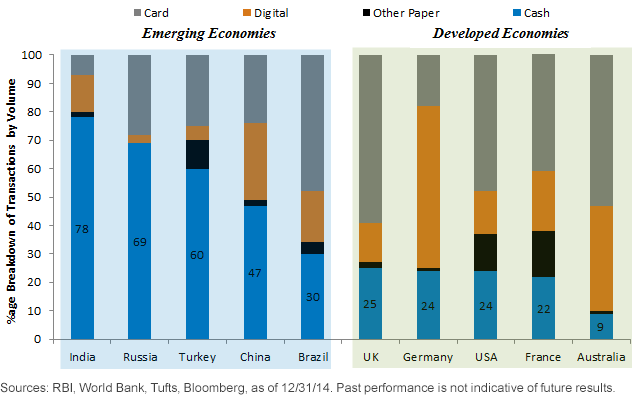How India Is Re-Engineering Its Economic Engine


As a popular adage goes, “Rome wasn’t built in a day.” There are times in history when the foundation for an empire was quietly built and the world realized it only later.
While we are busy discussing policies ranging from protectionism to immigration in the United States, India quietly laid the foundation for a technology empire that is going to digitally connect 17% of humanity. The full potential of India’s push for digitization will be realized in time, but in my mind this is perhaps the most exciting technology development happening in the world today.
Below I will highlight why investors should not ignore these developments and why they may be under-weight India even by its current economic size.
Networking 1.2 Billion People: The Potential Interaction in India’s $2.4 Trillion Economy
Unorganized employment in India forms a substantial part of the economy, employing nearly 85% of its 500 million-strong work force. Add to it king cash, which forms nearly 80% by value and 98% by volume of all financial transactions, and you are left with the world’s sixth biggest economic machine remaining largely unorganized and unnetworked!
India’s reliance on cash, which is often untaxed and unaccounted for, rivals the highest cash users in the emerging market (EM) world.
India's Reliance on Cash High Even in Emerging Markets

All of the above is about to change! As a first step in networking this economic superpower, in the last few years, the government of India has pulled off multiple feats that, in my opinion, the world has never seen before.
- World’s Biggest Biometric Database: Aadhaar
India has adopted and almost finished a biometric framework, Aadhaar, that uses fingerprints and retina scans of nearly 99% of its population, which essentially means 17% of humanity.1
This sophisticated biometric database—still missing in the Western world—is being used to connect every way an individual interacts with the overall economy. This will revolutionize the entire economy.
- World’s Biggest Banking Push: Jan Dhan Yojna
When WisdomTree spoke about this with the then-finance minister of India in 2015, little did we know about the seriousness of the Modi government’s push for banking for everyone.
Over the last year and a half, more than 270 million newer bank accounts have been opened with more than 665 billion rupees coming into formal banking.2 If this weren’t enough, all these accounts are linked to the biometric information, increasing efficiency in processes ranging from tax audits to transfer of welfare money and the elimination of middlemen.
- World’s Largest Interface Connecting Biometrics to Daily Transactions: IndiaStack
In 2016, India launched its own Dropbox, basically a vault secured by users’ biometrics to save and share all the information needed for daily transactions. It is called IndiaStack.
This interface is a one-stop shop available at the swipe of a thumb for all daily transactions a citizen needs to do—opening a bank account, buying and selling securities, paying bills, transferring money. This biometric connection will make India’s economy much more efficient.
- World’s Biggest Liquidity Crunch: Demonetization
Prime Minister Narendra Modi’s bold step to demonetize 86% of currency3 in November 2016 seems to have accelerated India’s economy toward cashless transactions.
Digital transactions increased 1,000% in December 2016.4 This also recapitalized India’s banks with a much-needed $100 billion and widened the government’s tax collection.
Thus, as India quietly lays the foundation to re-engineer its economic machine, we have an economy that is close to breakout velocity. While many talk of moving toward digital currencies, India has taken the most aggressive steps to formalize and digitize its entire economy.
Why Investors May Be Under-Weighting India
This all leads to a key question: Am I allocating to India correctly?
Investors often paint EM as one block and benchmark to the MSCI Emerging Markets Index. While this may give them very broad market cap EM exposure, it does not give them true economic exposure. In my opinion, investors are under-weighting India by allocating to the MSCI EM Index. Here is why:
India’s contribution to EM nominal GDP is around 17%; however, compared to its economic size, its allocation in MSCI EM is nearly half (i.e., 8.8%).5
Investors Under-Weighting India by Tracking MSCI Emerging Markets (EM) Index
![]()
Even if we forget about the impact of current reforms on future economic growth, we are still under-weighting India by tracking a market capitalization-weighted index like the MSCI EM Index.
As India’s market opens up for foreign investors and more foreign capital comes into the economy as a result of improving sentiments and liberalization of the economy, India’s market capitalization should increase.
Thus, investors looking for a true economic exposure should likely adopt a strategic over-weight to India compared to general market capitalization-weighted benchmarks.
In Conclusion
Usually the perception of India has been that of a country with significant potential but a very unorganized and messy system. As India networks its $2.4 trillion economy, it’s more than a trillion dollars of annual retail purchases, 1.2 billion people and 430 million Internet users6, we are witnessing a new era in the way it conducts business. This is going to remain one of the great investment opportunities of the next decade.
1Source: United Nations, as of 12/31/14.
2Source: Government of India, as of 2/28/17.
3Source: Bloomberg, as of 10/30/16.
4Source: Government of India, as of 12/31/16.
6Source: World Bank, IMF, as of 12/31/2016
Important Risks Related to this Article
Investments in emerging, offshore or frontier markets are generally less liquid and less efficient than investments in developed markets and are subject to additional risks, such as risks of adverse governmental regulation and intervention or political developments.Investments focused in India increase the impact of events and developments associated with the region, which can adversely affect performance.


